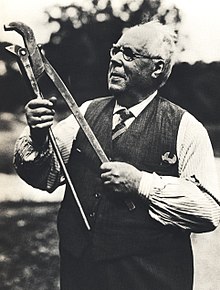Plumber wrench
This article needs additional citations for verification. (December 2009) |



A plumber wrench (or plumber's wrench, pipe wrench, Swedish wrench or Swedish pattern wrench[1]) is a form of plier described as a pipe wrench that uses compound leverage to grip and rotate plumbing pipes. Similar to the action of a Vise Grip plier, its jaw opening is adjusted to width by rotating a threaded ring. Its advantage is that it grips with significant force without needing to engage a lock nut like an adjustable tongue-and-groove plier. Like these, it can also be used on nuts, particularly hex shaped, and other flat engagement points. If used carelessly it can dent or break plumbing pipe.[2]
History[]
The plumber wrench was invented in 1888 by the Swedish inventor named Johan Petter Johansson. It shares some principles with both the Stillson-pattern pipe wrench and the rigid pipe wrench, as well as various forms of adjustable pliers, such as the Vise Grip and "Channelock" tongue-and-groove plier.
Johansson's tool is used rather than a pair of tongs[clarification needed] to separate or join[clarification needed] pipes.[3] It is not widely known in North America, but is common in Europe.[1]
Johansson also improved the adjustable wrench, with a patent in 1891.[4]
See also[]
References[]
- ^ a b "Wrenches and accessories". Atesina S.p.A. Retrieved 2015-03-08.
- ^ "Plumbing Tools List – List of tools that plumbers use". Certified Plumbing. Retrieved 1 April 2020.
- ^ "The History Of Plumber Wrenches And Their Uses". Plumbers 911. Archived from the original on 3 October 2015. Retrieved 5 August 2015.
- ^ "The History of Bahco". Bahco. Retrieved 2016-11-11.
- Plumbing
- Wrenches
- Swedish inventions